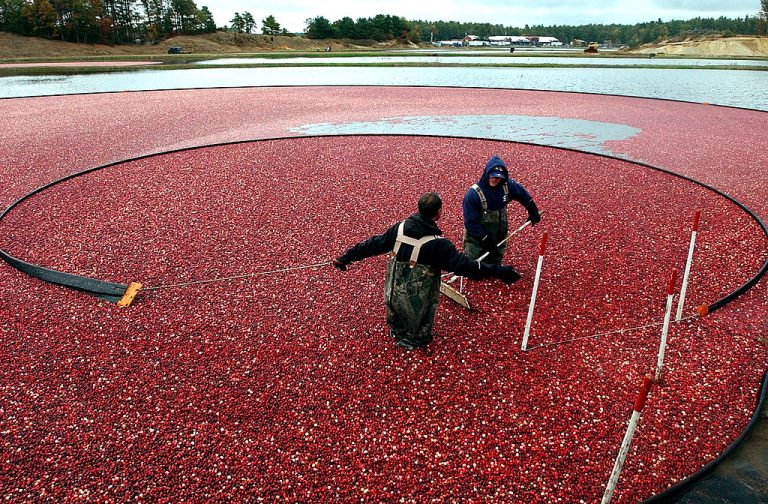A Thanksgiving staple may be in jeopardy this November as American cranberry producers struggle with a seasonal drought that comes on the back of multiple seasons of flooding and other disasters.
According to data from the University of Nebraska-Lincoln’s Drought Monitor, as of Sept. 13, the entire state of Massachusetts is suffering from a state classified at least at the level of “Moderate Drought.”
Large portions are suffering from “Severe Drought,” with several sectors being tagged as “Extreme Drought.”

UNL explains on its website that the “Moderate” level is already defined as being accompanied by crop and pasture damage with wells and streams at low levels and water shortages imminent.
The “Severe” moniker is defined as a state where crop damage is already sustained, water shortages are likely, and water restrictions are imposed, while the “Extreme” label is reserved for “major crop/pasture losses” in addition to widespread water shortages and restrictions.
Success
You are now signed up for our newsletter
Success
Check your email to complete sign up
In a Sept. 14 article on the cranberry shortage from the standpoint of the globalist carbon climate change narrative, Grist explained, “Cranberries are a finicky crop. Too much water, like the state saw last year, can cause fungus to grow on cranberry vines and affect the color and quality of the fruit. But add too little water, and the vines shrivel up and die, or the berries don’t grow to full maturity.”
MORE ON TROUBLE FOR U.S. FARMERS
- Now There’s a Ketchup Crisis? Drought Demolishes California Tomato Crop
- Barely Half of America’s 2022 Corn Harvest in Healthy Condition
- This Year’s Droughts Are Crushing the US Cotton Industry
The outlet added that cranberry farming is also special in that the berries grow on vines in dry fields like grapes, but require being flooded with water and turned into bogs twice a year.
“In the spring, when a late frost might threaten to kill their budding cranberry vines, the flooding protects the tender shoots and flowers from freezing over,” Grist explained. “In the fall, farmers turn on their irrigation systems again to harvest their berries.”
The publication added, “They [farmers] use machines to shake the plants to release the berries into the bog, where they’re corralled into containers and shipped to destinations across the country.”
According to the University of Massachusetts Amherst, the state is not only the second largest producer of cranberries and home to the two largest processing facilities in the nation, but cranberries are its largest crop, valued at almost $100 million annually.
Cranberries create 6,900 jobs and represent $1.4 billion dollars of the Massachusetts economy, the University adds.
Grist recounted the anecdote of former farmer Peter Hanlon, who sold his generational farm because his children did not want to carry on the tradition.
One huge factor in the decision, Hanlon stated, was chaotic storms in 2015 and 2017 that brought an 11 foot wave of ocean water into his fields, destroying his vines via salt exposure.
However, the trouble for cranberry producers may not be the breaking carbon narrative that Grist is peddling.
In 2021, Milwaukee Journal Sentinel reported that its state of Wisconsin, the largest producer of cranberries in America, was likewise anticipating a significant shortfall to supply Thanksgiving and Christmas festivities.
However, rather than drought, what hurt the Wisconsin crops was “the combination of a warm April, causing the perennial cranberry fruit to bloom, and then a hard frost in May,” the outlet stated.
One farmer in the Wisconsin Rapids area told the outlet that what cost her 30 to 50 percent of 2021’s crop was neither drought nor abnormal temperatures, but a series of early June hailstorms that crushed her operation’s season right as the plants were beginning to blossom.
The outlet estimated that Wisconsin’s 2021 production would fall to 4.5 million barrels from 5.5 million the year prior.
And the overall economic situation may not be as dire as the picture painted. A 2021 article by trade industry magazine FreshPlaza revealed that “processed cranberries are also coming out of a decade of oversupply.”
Kevin Tritz, a Wisconsin cranberry farmer, told the publication, “A couple of short crops in a row, coupled with COVID driving juice and SDC sales, has helped chip away at the oversupply.”
Tritz explained, however, that damage to cranberry crops can nonetheless be significant in the long term because the plants need three years to develop and settle before they start producing fruit.
Some farmers, he said, had uprooted their vines in favor of modified high yield varieties. On the one hand, Tritz lauded the effort because, “In a lot of cases production doubles or even triples.”
But the farmer was paraphrased by FreshPlaza as adding the caveat, “Often the new high-yield varieties are not suited for fresh cranberry production given that fresh cranberries typically call for a heartier berry with a strong shelf life.”
















